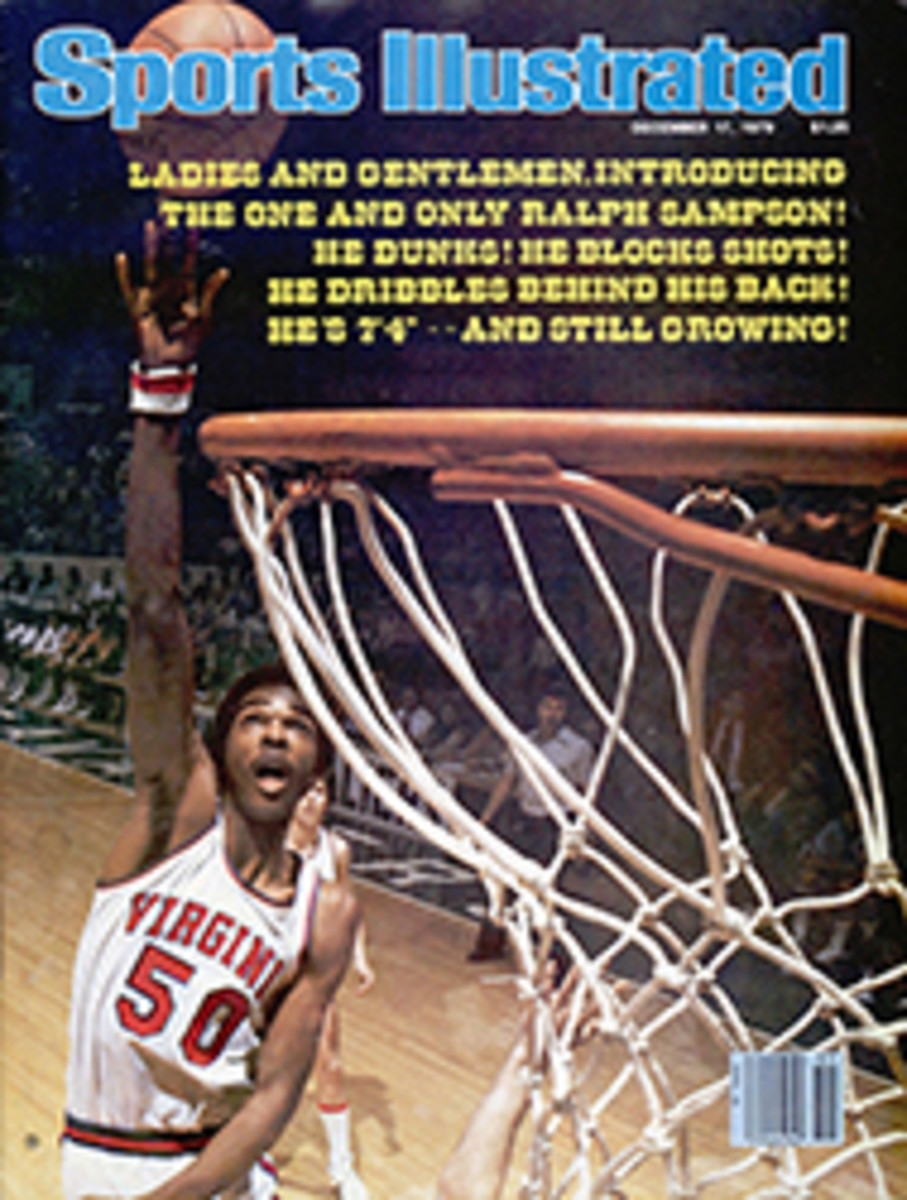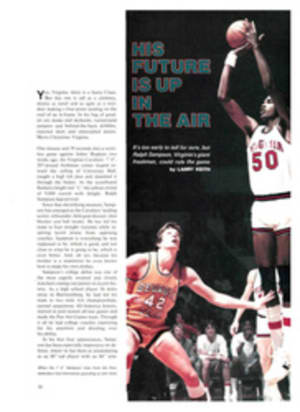
SCORECARD
PROPORTIONALITY FOR ALL
Last week the Department of Health, Education and Welfare released its final Title IX interpretive guidelines, aimed at eliminating sex discrimination in school sports programs. In issuing the department's 41-page report, HEW Secretary Patricia Harris said, "After reviewing 700 comments and consulting with representatives of colleges and universities, we believe we came up with a sensible, flexible policy. We're not saying 'move over' to football or to any sport. We're saying to discrimination, 'let it end.' "
Where the new guidelines differ from past provisions is that they specifically list how the equivalence of benefits are to be measured, particularly in athletic scholarships. The revised policy directs that if the ratio of men to women athletes in an intercollegiate program is, for example, 7:3, the financial-aid distribution must be proportional.
Charles Neinas, commissioner of the Big Eight, called the move "pragmatic," and Missouri Athletic Director Dave Hart agrees. "We have 430 athletes involved in our program and 149 are women," he says. "We are spending $708,000 on scholarships. Of that amount, the women get $188,971. That leaves us about $61,234 short. If HEW had gone for an equal per capita expenditure none of us could have made it."
Donna Lopiano, University of Texas women's athletic director, welcomed the latest ruling, though she doubts it will affect Texas because it is close to compliance now with a $3.5 million annual budget for men's sports and a $900,000 budget for women, including 46 full and 30 partial scholarships. "Many schools that had been making progress with their women's programs went into a stall when the [old] guidelines were issued a year ago," she said. "I am pleased that something final is out and that it is clear."
However, Don Canham, who directs the athletic program at Michigan, was not pleased. "I can't understand why the academic community across the country is not upset," said Canham, whose men's scholarship budget is $800,000 compared to $200,000 for women. "HEW has gone beyond what the law intended in its interpretation. It is telling us how to spend funds contributed by alumni for scholarship programs."
And while AIAW President Carole Mushier called the new policy workable enough "to permit each institution to design and implement its own nondiscriminatory athletic program," Walter Byers, executive director of the NCAA, said, "It is not only extremely complicated, but it will result in fewer athletic opportunities for both men and women students."
When she released the report, Secretary Harris said, "We would expect that as schools amend their programs, they would do so with sensitivity and with recognition that such changes should result in enhancing, not minimizing, the role of women...in sports programs."
Amen. The idea of proportional spending seems a fair way to deal with the sexual inequity of sports programs and a rational way to nurture the much-needed growth that eventually will offer the most opportunities to the greatest number of athletes.
WHO'S NO. 1?
It seems that as long as the national championship of college football is settled in the polls instead of on the playing field, there will be controversy. Such was the case last season when the two wire-service polls, AP (writers) and UPI (coaches), produced different winners, the AP voters selecting Alabama, the UPI balloters choosing Southern Cal.
In last week's final regular-season voting, UPI had undefeated Alabama on top, just as it had most of the year, but the Crimson Tide dropped to second in the AP poll, with Ohio State, also unbeaten, becoming No. 1. The Tide had nearly twice as many first-place votes as the Buckeyes, but eight writers failed to select Alabama among the top three, thus accounting for the demotion.
Putting aside the various factors that influenced the voters in both polls, the overall result is perfectly justified—although fans of Florida and BYU, also unbeaten and untied, might disagree. Unlike last season, when USC had played and beaten its rival for No. 1, Alabama, the Crimson Tide and Buckeyes have not met, nor have they played a common opponent. There isn't much to choose from between the two. Ohio State has scored more points, but Alabama has yielded fewer. Alabama's schedule was weak, but Ohio State's was no monster. USC, also unbeaten but with a tie, may well do away with the Buckeyes in the Rose Bowl but until the bowls are played, both Alabama and Ohio State should be content with half a loaf.
GOING ONCE...GOING TWICE...
How can the exorbitant prices being bid for this year's baseball free agents be explained? Nolan Ryan, the plum of the draft, though barely more than a .500 pitcher during his 12-season career, signed a four-year contract with the Houston Astros reportedly for a staggering $4.5 million. But Ryan may not be the best example of how prices have soared. Take John Curtis, 31, a mediocre lefthander who was 10-9 and had a 4.17 ERA last season for San Francisco and who is 67-72 during his 10-year career. He recently closed a deal with San Diego for a reported $1.7 million over five years. In fact, of the 15 free agents—11 of whom can be safely described as run-of-the-mill players—who had signed with new clubs last week, 11 came away with million-dollar agreements.
Milwaukee General Manager Harry Dalton calls it the auction syndrome. "You go to the auction and see an old moose head that you never thought about until you got there," Dalton explained to Thomas Boswell of The Washington Post. "The auctioneer says, 'Available today only and never again. Here's your once-in-a-lifetime chance.'
"So you get auction fever. Then, when you get the damn moose home and put it on your mantelpiece, it looks hideous and contradicts the style of everything around it and you want to throw up.
"I don't want to denigrate the players in this year's draft, but I think a lot of teams have bought a lot of ugly moose heads."
SON OF PING-PONG DIPLOMACY
It may come as a surprise to some people that the Palestine Liberation Organization has a professional table-tennis team that competes internationally. But, indeed, the PLO squad was scheduled to challenge the defending world champion Royal Haiti team for the title this week. Now there are a couple of worthy opponents!
According to Windsor Olson, president of the International Table Tennis League, the match had been set for Dec. 17 at the Seattle Center Play House, and a sellout crowd of 800 had been expected. Although no one in the U.S. knows much about the PLO team, it had been selected—there are no elimination rounds in professional table tennis—by the league's international referee, Seattle businessman Lee Phelps, in the hope of fostering a diplomatic breakthrough, as the early matches with the People's Republic of China had done.
Olson, who's also the manager of the Seattle Sockeye professional table-tennis team, had been corresponding with aides to PLO leader Yasser Arafat for the past few months, but except for one name, B. Nassar, Olson had received no information about team members. His final contact with the PLO was on Nov. 12.
That was eight days after Iranian students seized the U.S. Embassy in Teheran and took 62 Americans hostage. At that time, Arafat stepped forward with an offer to negotiate with the Iranian government on behalf of the U.S. Someone in the Middle East apparently thought better of having a PLO table-tennis team in the U.S. while the situation in Iran was so volatile, and contacts with Seattle were abruptly cut off. Olson reluctantly canceled the match and told the Haitians, who beat the U.S. in 1977 and Thailand in 1978, that they could keep their title without defending it. But he and Phelps were disappointed. "It would have been interesting to see the PLO's style of play," Phelps said.
FOR PETE'S SAKE
It took very nearly five games during which Pete Maravich sat at the end of the bench for the worst team in the NBA before any but the most loyal followers of the Jazz to realize that the Pistol's career in Utah—and perhaps in pro basketball—is for all practical purposes shot. For five seasons he had been the franchise for the Jazz. As recently as 1976-77 he led the league in scoring. But when the team was moved to Salt Lake City last summer, Maravich discovered that his Bourbon Street act wouldn't play on the shores of the Great Salt Lake.
Pistol Pete, 31, missed the Jazz' Nov. 30 game at Golden State because of illness, and when Utah won 112-104 that night to end a 14-game losing streak, it confirmed what Jazz Coach Tom Nissalke had suspected for some time: that Maravich's 17 points a game weren't worth the disruption the Pistol created by dominating the ball. When Utah beat Seattle at home the next evening, Maravich was healthy again but still on the bench. That was where he remained for six straight games through the end of last week, a period in which the Jazz raised eyebrows around the NBA by winning four games.
Utah General Manager Frank Layden, whose shrewd deals have made the Jazz respectable in quick order, admits Utah wants to trade Maravich. "I'm going to get rid of the losers," Layden says. "There's no future for Pete here, and it's better to move the guy this year before he's established an identity in Utah. There are several owners who would love to have a gate attraction like Pete, but the coaches are afraid of him. I wouldn't be surprised if he just packed it in if he can't get on with a contending team in the next few weeks."
Utah is evidently willing to pay Maravich's $500,000-a-year contract for the next two-and-a-half seasons to any team that would take him, but as one Jazz official noted glumly, "We would take any player in the league for Pete, but nobody else wants him."
Maravich has been largely silent throughout his ordeal, but he did tell Dave Blackwell of the Deseret News, "It's like being in an airplane, you don't have any control. Maybe I've overstayed my welcome. I doubt whether I'll finish the season here, yet I really don't believe another team would pick me up. My salary is just too large, so I guess you could say I am a victim of my own circumstances."
WHIP INFLATION NOW
It isn't everyone who can be sent down to the minors and get a pay raise at the same time, but that is exactly what Goalie Markus Mattsson got when the NHL Winnipeg Jets sent him to their Central Hockey League team, the Tulsa Oilers, in October. For the last two years, when the Jets were part of the now-defunct WHA, Mattsson had played in Canada for an annual salary of $80,000. Now in Oklahoma, he is drawing the same pay, except it's in U.S. greenbacks, which are worth about 15% more than Canadian dollars. That converts to about $12,000 a year more than Mattsson earned in Winnipeg.
Major league baseball, with teams in Montreal and Toronto, has avoided dealing with the currency inequity by having all players paid in U.S. money. The NHL offers no such option. Canadian franchises pay their players in Canadian money, U.S. franchises pay their players in U.S. money.
Of course, double-digit inflation in the U.S. may eventually catch up to Mattsson, but in the meantime, any damage to his ego because of the demotion has been soothed. "I enjoy making more money," he says.
ILLUSTRATION
THEY SAID IT
•Tony (Mac the Sack) McGee, New England Patriot defensive end, describing how he felt after a sackless game against the Miami Dolphins: "Angry. Disappointed. Mad. Sad. Disgusted, busted and can't be trusted."
•Isaac Stern, violinist, apologizing to the audience for his late arrival at a Sunday concert in Chicago Orchestra Hall: "I was competing with all those Bears fans for a taxi. Had my name been Walter Payton, I'd have had no trouble."

